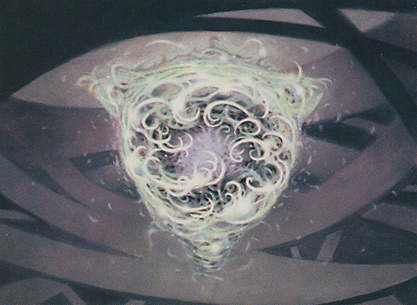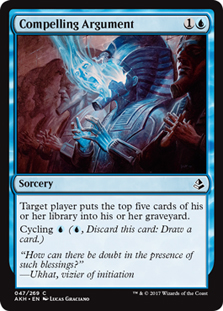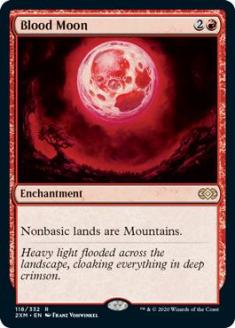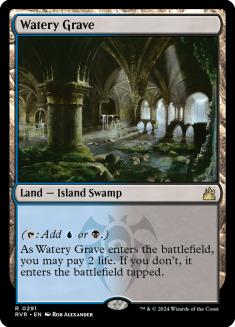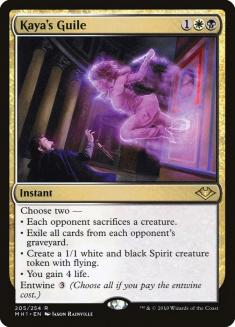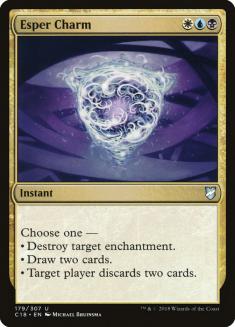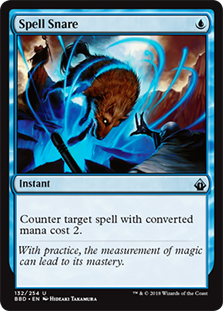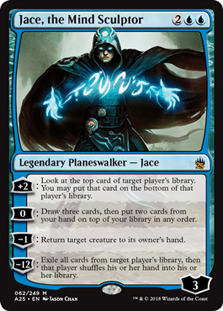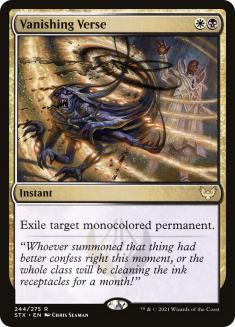Esper Control may be the best deck in Modern.
That statement is not a shocker coming from me, but there are other, less-biased professionals parroting similar talking points. My buddy Ari Lax recently wrote an article that sang the praises of my favorite archetype. Either hell froze over or Ari truly believed that Esper Control was in a prime position to take down the best decks of the Modern format. I come predisposed with this faith in the archetype, but Ari leans a bit more analytically than I do. If the numbers prove it, he will follow, and that’s why I have learned a great deal from him throughout the years.
Here’s his Twitter status that proves I did not coerce him into writing this analysis.
When Ari and I disagree on a specific card’s strength, or the state of a competitive metagame, we have wonderful, public discourse for the world to see. He’s not shy to call me out and vice versa, which is why I knew he would be a great sport when I gave him this very public feedback on his article. There are some aspects of this piece that I completely agree with, some I disagree with, and some that I never thought about until he brought them to light. That’s the beauty of metagame analysis, deckbuilding, and competitive play in general. These types of discussions and disagreements ultimately build a better product and give insight to our readers of how professional teams work.
Ari and I teamed for a Pro Tour back in the day, but have been separated for most of them. I’m confident that he would echo my experiences, including the back-and-forth on deck creation, using the expected metagame as the basis for the disagreements. We can all agree that Teferi, Time Raveler is a very strong card in control; however, there are reasons why some Esper Control builds have one in the maindeck, have just one in the sideboard, or, like Ari, omit them completely. Let us start by looking at his list, where I disagree and agree, and what we can learn from his discoveries.
Creatures (4)
Planeswalkers (4)
Lands (25)
Spells (27)

His metagame analysis with this deck and why it’s a heavy hitter in Modern is on point. With the removal of Uro, Titan of Nature’s Wrath, control decks have a lane to dominate the fair metagame. Modern has dropped a few power levels with the bans over the years and the best decks in the format operate within the margins of a traditional match of Magic. This means there are very few decks that can “go off” before a control deck can effectively interact, or prior to receiving lethal damage from a strong aggro draw.
The new reality of Modern has created a top tier of decks that ramp through Urzatron lands or to a Primeval Titan, trade resources and produce big threats, create card advantage through control options, or have an aggressive gameplan, with some that can also combo off within their creature package. This list of successful strategies in competitive Modern stems from a lack of broken combo decks, with an absence of Uro once and for all.
Without Uro around, control decks can craft a strategy that handle the big mana decks, while dispatching creature-based decks with ease. I often look toward Azorius Control to handle this task in Modern, often tabling any Esper Control aspirations, due to the big elephant in the room. Esper Control deals the user a ton of damage from its mana base and is more vulnerable to Blood Moon. That latter is going to always be impossible to avoid, but luckily Blood Moon is an enchantment that can be removed by hand disruption, a cheap counter spell, or having the mana open for a timely Esper Charm. That said, the damage from the manabase is tough to manage if the metagame shifts more heavily toward aggro decks.
Aggro decks have had an issue defeating Azorius Control over the years in Modern but punishes those who venture into the black splash. Once Kaya’s Guile was printed, I knew things were going to get better for Esper Control fans and it did for a while. I tested decks that looked very similar to Ari’s and the successful Magic Online lists that he was basing his off, except the metagame was too hostile then. When Kaya’s Guile was released, the format still had a host of spells that were just recently banned, making it difficult to navigate the waters with a fair control deck. Now with the lifegain built into Esper Control and the maindeck graveyard hate, the deck finally has a chance to shine in competitive play.
Another point where Ari was dead on was the strength of Esper Charm. I was one of the non-believers in playing multiples of this spell once Kaya’s Guile came out because even though it’s the superior source of card advantage, the battlefield-affecting versatility was weaker. Esper Charm assisted the most when you’re slightly ahead, where Kaya’s Guile helped you claw back from heavy life loss, a giant creature, or a problematic graveyard. I also enjoyed using the Spirit it created when I tried Esper Stoneblade for a few months, making it the obvious choice.
The two copies of Esper Charm in Ari’s list are the perfect number, for all the reasons he mentioned. There are multiple scenarios in this grindy metagame where the discard is an essential piece of the victory puzzle and is strengthened even more with Snapcaster Mage by your side. The pile of three-mana interactions that Ari calls out on a few occasions makes total sense for the metagame we’re trying to tackle together here.
A controversial agreement I have with Ari is the weakness of Spell Snare in this metagame. In an aggro fantasy, filled with Dark Confidant and Eidolon of the Great Revel, Spell Snare can get by. Modern, while full of fair decks these days, does not have a large enough pool of two-mana threats to justify disruption that only handles them.
It took me a while to come around to its weakness in Azorius Control, which incorporated multiple copies of it for a defensible reason. Azorius Control doesn’t have good removal outside of Path to Exile and needed blue disruption to stop creatures from making their way through. With Drown in the Loch and Kaya’s Guile, Esper Control has some backup in that department. Even if more two-drops made their way to the top of the format, there’s no way I would call Spell Snare for assistance. The closest I will get is Inquisition of Kozilek, which can handle a much larger swath of threats than the narrow blue alternative.
I do have a few disagreements with Ari’s list and position on Esper Control in the format. The biggest area of concern is his stance on Supreme Verdict. He mentions that it’s not a “clear two-for-one” in a format where the threats are big enough to eat you on their own. Creatures like Death’s Shadow and Monastery Swiftspear are must-kills, which he correctly identifies.
This position sounds great in theory. There’s little reason to play Supreme Verdict when the spot removal can easily remove the threats at a much cheaper rate than a sweeper, but Magic is not that clean. I wish that were the world we lived in, where the Death’s Shadow player promised to play one creature at a time, or the Boros Prowess player held back their other three one-drops they’re holding.
The reality is that players know the sweepers in Modern are light and that most control players do not even house them in their maindeck. For this reason, players are heavily inclined to play out multiple threats that are each lethal on their own, to protect against the one-for-one response that Esper Control players are heavily dependent on.
When creature-based decks emerge victorious in Modern, often it’s due to overwhelming the battlefield with threats. Decks like Selesnya Company have a bunch of nonsense they drop onto the battlefield, requiring a sweeper for us to regain control. Modern is full of decks like this, and even though they’re not dominating now, they do exist.
Not having access to Supreme Verdict anywhere in the 75 of Esper Control results in maximum punishment when you face these opponents on the outer tiers. Therefore, most of the Esper Control decks, outside of those run by master Guillaume Wafo-Tapa, that have done well online housed at least a couple between the maindeck and sideboard. The cost of having it take a few slots is minimal compared to the destruction faced when not having access to it.
The printing of Force of Negation was a blessing for control players in Modern for a few reasons. The first and most obvious strength is the ability to combat a noncreature spell when tapped out on the opponent’s turn. The second-best aspect of Force of Negation is that we can now play Supreme Verdict more liberally, knowing we can toss it to counter a spell when it’s unneeded.
There are very few matchups Supreme Verdict is dead against, but where it is, Force of Negation puts it to use. I have tested control decks completely void of sweepers in combo-heavy formats, but quickly learned it was a mistake.
The other deckbuilding disagreements I have with Ari are minor in comparison to Supreme Verdict. I like having more than one copy of Jace, the Mind Sculptor in this metagame. Its ability to run away with the game upon resolution is legendary and I fear cutting the second copy reduces that outcome significantly. I would add that back to the list, replacing one Archmage’s Charm, reducing the glorious pile of three-mana interaction spells to seven. The number increases some when you consider a possible Snapcaster Mage, recasting Opt or Fatal Push, but it’s not going to occur every game.
There are other alterations I would make to the maindeck numbers, but they’re solely based on personal preferences. I enjoy a deck that’s almost entirely reactive, with a few broken planeswalkers to tap out for. This Esper Control deck embodies those principles, and this is the list I have played quite a bit with since its recent renaissance on Magic Online.
Creatures (4)
Planeswalkers (4)
Lands (25)
Spells (27)

The other areas of disagreement in deck building I had with Ari were centered around Vanishing Verse and Teferi, Time Raveler. These cards are locked in my sideboard due to their versatility of usage in the current metagame. Vanishing Verse is much stronger than any of the other two-mana removal spells, as it hits any monocolored permanent at instant speed. This range makes it a perfect Modern sideboard card, with strong potential of being a staple in the maindeck soon.
Out of all the matchups Ari mentioned, Vanishing Verse is dynamite against all but Eldrazi Tron. The reason why it does not earn a maindeck spot is just that — avoiding a true dead card against them. Since we all agree the manabase cannot handle Field of Ruin, the spell selection must be done carefully to avoid an easy loss against colorless threats.
Teferi, Time Raveler as a one-of in the sideboard breaks my heart. Although the metagame isn’t as hostile as it once was, there are too many opponents summoning one-drops to make it viable. If the metagame shifts away from aggro and into the arms of midrange or control, Teferi, Time Raveler will be a vital piece in the success of Esper Control.
For this metagame, I agree with Ari’s position on it, but disagree with omitting it completely. The effect it produces is too broken and its ban from other formats was for good reason. As the strongest weapon against Veil of Summer and blue disruption, Teferi, Time Raveler will always be somewhere in my lists.
I want to end this mild rebuttal of my pal’s article with a thank-you. Thank you, Ari, for teaching me the futility of Godless Shrine in this deck while also trying to cast Archmage’s Charm. Even with a reduced number of Archmage’s Charms, Cryptic Command also scoffs at the inclusion of Godless Shrine and the single Swamp we must run.
I wish the Swamp could get cut as well, but that can never happen in Modern. Having access to an untapped, painless black source is vital with Fatal Push (or any black spell for that matter). His manabase is one of the better ones I have seen and gets bonus points from avoiding Mystic Gate and River of Tears, which often lead to disastrous mana issues on their own.
Overall, Ari’s article was great and the disagreements I had were based on current gameplay, not the centuries of dedication to the greatest shard of all time. One thing is for certain — Esper Control is crushing Modern and I’m loving every second of it.

